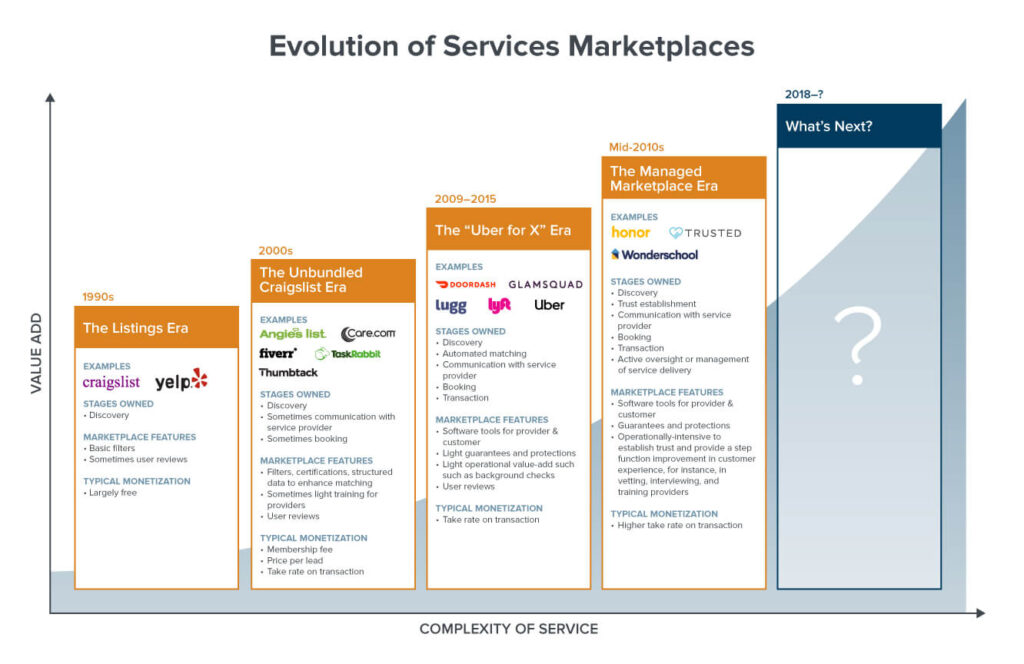Li Jin

Crypto and Net-New Marketplaces
The biggest companies on the planet are marketplaces built on network effects. Amazon ($1.9T), Meta ($1.2T), Tencent ($459BT)—all aggregate supply and demand, and their networks grow more valuable the more of that supply and demand they control.
The same holds true in crypto. Top-valued networks like Bitcoin ($1.4T), Solana ($79B), and Ethereum ($460B) are all multi-sided networks comprised of developers, users, and network operators that become more valuable as they scale.
But when I look at the landscape of marketplaces across web2 and web3, I don’t just see the marketplaces that already exist; I see the ones that don’t exist yet.
In my years investing in marketplace startups, I have learned that there are marketplaces that should exist—that would help supply and demand find each other and provide significant utility to both sides—but that don’t exist today because of limitations inherent in the systems they are built on. I have also seen firsthand how new technologies can unlock opportunities for new marketplaces to emerge and thrive.
Marketplaces are the most exciting opportunities in crypto. By leveraging crypto’s killer capabilities of token-incentivized scale and onchain composability, builders can create new marketplaces that serve pockets of demand that have, until now, gone unaddressed. It’s an opportunity for stepwise, rather than incremental, innovation.
Systemic Barriers to Marketplace Innovation in Web2
I’ve previously written about the eras of services marketplaces, specifically how the category of internet marketplaces evolved from the listings era exemplified by Craigslist in the ‘90s, through the “Uber for X” era of on-demand apps (2009-15), up to the era of managed marketplaces (mid-2010s).
Source: a16z, Li Jin and Andrew Chen
Each of these eras developed in response to either a new technology or an emerging market need. In the listings era, the internet enabled individuals to post and find listings online. The “Uber for X” era emerged in tandem with smartphones, which facilitated immediate access to various services and leveraged users’ real-time location. Managed marketplaces emerged as a response to the need for more trust in complex markets after low-hanging opportunities in marketplaces had been exhausted.
However, each era also brought challenges that limited innovation. In the listings era, a lack of trust and standardization constrained growth. In the on-demand era, scaling marketplaces to offer near-real-time services entailed massive capital requirements. And with managed marketplaces, high operating costs associated with establishing trust for transactions impacted these marketplaces’ viability.
Many of these challenges persist in web2 marketplaces, in ways that hamper innovation. Two problems in particular that hinder progress—and that crypto is uniquely positioned to solve—are scaling and trust.
The Scaling Problem
Traditional web2 marketplaces can be incredibly expensive to build and scale—especially when there’s a need for significant scale before the marketplace has utility. This need for capital creates a barrier to entry for new players. It also means that entire categories of marketplaces don’t get built because the costs are too high to achieve the scale required to provide utility.
For example, consider dating apps. In a dating network, there needs to be a significant scale of users on both sides to facilitate good matches. Traditionally, this has meant platforms must spend a lot of capital to attract large numbers of users before the application is useful to any individual user. Dating apps also suffer from low retention because if they’re successful, users churn, creating further obstacles to scaling. As a result, there are few breakout winners in the dating category.
The Trust Problem
A second persistent challenge in web2 marketplaces is trust. Some industry verticals require high levels of trust between marketplace participants for transactions to take place. For instance, in some categories, there are very high stakes to matching with the right provider/service (e.g. babysitting or eldercare). Others have very high-order values (e.g. luxury goods, art, real estate).
In order to establish the requisite trust, managed marketplaces have built out additional services and operational layers. For example, childcare marketplaces extensively vet babysitters before they can transact on the marketplace—including interviewing providers in real life, performing background checks, and building out software tools to provide real-time visibility and location. In real estate, some managed marketplaces have taken ownership of the entire end-to-end process, from performing repairs to acting as essentially a market maker for homes (“iBuyers”). These additional operations create significant overhead. In addition, other marketplaces that want to list that supply/provider must duplicate that effort, resulting in inefficiencies across the market.
Solving the Problem: Crypto’s Killer Capabilities
Viewed against these challenges, crypto has three killer capabilities that unlock new potential vectors for marketplace innovation: scale, onchain reputation, and payments.
Scale
If there is one thing crypto excels at, it’s scale. Crypto incentives (in the form of tokens) have proven incredibly powerful tools for driving growth.
In contrast to web2 marketplaces that must grow supply and demand in tandem, the financial incentives offered through tokens enable marketplaces to grow sequentially, leading with supply before scaling demand. For example, decentralized physical infrastructure networks (DePINs) Helium and Hivemapper bootstrapped their supply side by providing token incentives to participants before the revenues of the underlying networks caught up.
You could apply token incentives to many types of marketplaces that don’t exist due to high bootstrapping costs. Imagine hyperlocal social networks that require a high density of users to work (think Citizen but more generalized for information or real-time events) or new dating applications. In AI, we’re already seeing builders apply token incentives to create new marketplaces that don’t have precedent in the web2 world. For example, networks like Vana and Rainfall enable users to contribute data for AI training and get rewarded with tokens. The aggregation of long-tail, private, hard-to-access datasets would be near-impossible without contribution from a large scale of users mobilized with intelligent incentives.
Onchain Reputation and History
A challenge outlined above in the world of web2 marketplaces is the duplication of effort across siloed marketplaces in establishing trust. For example, Uber runs background checks on all new drivers, but when that same driver downloads Lyft, the app also performs a background check because the platforms are siloed.
One of crypto’s applications is as a system for portable reputation. Rather than each app requiring a separate background check, what if that information were stored onchain, traveling with that driver no matter which marketplace they joined? Going further, other information about providers’ history—like their reliability and quality—could be represented onchain, enabling marketplaces to compose and tap into a global store of trust. Such a system could obviate the need for disparate managed marketplaces to implement their own capital-intensive processes. In web2, many managed marketplaces provided excellent user experiences but were ultimately not viable as businesses due to high operating costs. Global onchain reputation can fundamentally alter their cost structure.
You can find a microcosm of this idea in the Farcaster ecosystem. The social media protocol stores posts, likes, follows, and profiles in a decentralized network of hubs. When users install different apps built on the protocol, their social data moves with them. Already, we’re seeing headless marketplaces arise on Farcaster. One example is Bountycaster, where users can post and discover bounties across any Farcaster client, tapping into the rich reputation data on the Farcaster network. You could imagine various new marketplaces arising out of the Farcaster ecosystem because of this portable social data, from smart contract auditing marketplaces to expert marketplaces that leverage the connection graph and reputation of Farcaster.
Payments
Facilitating payments is a core component of modern marketplaces, but in web2, supporting payments cross-border requires internationalization across various local systems. This is especially pertinent for digital marketplaces, where customers and suppliers are often far apart. For example, more than 80% of YouTube users live outside of the US. To support local currency payments in each geography, platforms must integrate with international payment gateways. Often, that leaves long-tail geographies unserved, particularly by newer marketplaces or platforms without the resources to internationalize.
Crypto works internationally from the outset, enabling transactions between anyone with a crypto wallet. That allows marketplaces with limited resources to have global reach from day one. For example, I recently purchased an NFT for bytexplorers, an onchain data community, which allowed me to ask a data-related question to its community of analysts. Analysts who answer correctly get rewarded with tokens, enabling seamless payment and global participation.
The Next Generation of Marketplaces
If my years investing in marketplace startups have taught me anything, it’s that the best opportunities happen when builders leverage new technologies to create significant improvements for end users. Each generation of marketplace builders has leveraged new technology to unlock the creation of new marketplaces that couldn’t have existed before.
Crypto represents the next stage of this evolution. By leveraging token incentives for scaling, new marketplaces can grow in a more capital-efficient manner. Onchain reputations and histories can reduce overhead for any given marketplace operator. Crypto-based payments allow marketplaces to operate seamlessly across borders from day one. All of this will not only improve existing marketplaces but also give rise to new marketplaces that could only exist with new cost structures and scaling tactics.
If you’re a builder creating a marketplace in crypto, please reach out—we’d love to talk.
+++
This post is for general information purposes only. It does not constitute investment advice or a recommendation or solicitation to buy or sell any investment and should not be used in the evaluation of the merits of making any investment decision. It should not be relied upon for accounting, legal or tax advice or investment recommendations. You should consult your own advisers as to legal, business, tax, and other related matters concerning any investment. Certain information contained in here has been obtained from third-party sources, including from portfolio companies of funds managed by Variant. While taken from sources believed to be reliable, Variant has not independently verified such information. Variant makes no representations about the enduring accuracy of the information or its appropriateness for a given situation. This post reflects the current opinions of the authors and is not made on behalf of Variant or its Clients and does not necessarily reflect the opinions of Variant, its General Partners, its affiliates, advisors or individuals associated with Variant. The opinions reflected herein are subject to change without being updated.
Variant is an investor in Farcaster.

